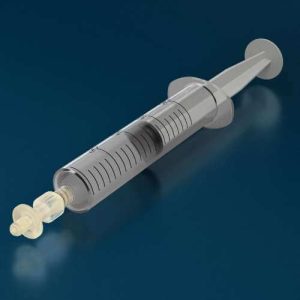Innovation in IC/BPS Treatment
Dr. Sándor Lovász MD. PhD., is one of the few people dedicated to making life better for those who must live with interstitial cystitis/bladder pain syndrome (IC/BPS). He has been diagnosing and treating IC/PBS patients for more than a decade.
Being one of the experts in the field, he realized a paradox. In severe cases, local treatment – bladder instillation – could be the most effective way of alleviating the symptoms. But it is performed with a catheter. Catheterization itself, on the other hand, has serious drawbacks. The pain caused by the device and the risk of infection caused by it makes many patients hesitate to accept catheterization. Dr. Lovász also knew although catheterization had improved a lot in previous decades, the basic principles hadn’t changed much.
Then he realized: if the device caused the most issues, it would be best to get rid of the device itself – and replace it with something else.
Obviously whatever device replaces the catheter must be slim enough to penetrate the urethral orifice, but still deliver the solution itself. Moreover, it’s easy to deliver some liquid into the urethra, but to make it reach the bladder requires pressure – or else it simply flows out of the urethra. If the original source of the liquid to be instilled is a syringe, the new device must fit its tip easily and firmly. Finally, the device must be made of a material that’s biocompatible and can be easily sterilized.
The questions raised were solved in multiple steps – and the result was the UroDapter we know today. It’s made of medical grade plastic; it penetrates the urethra only a couple of millimeters deeply; its isolating collar ensures that the instilled liquid (as the pressure raises in the urethra during the instillation), flows into the bladder; the ribbed part of the device enables firm grip for the user.
It took little time until the patients started to prefer the new device. Those who needed regular instillations could easily feel the difference: much less pain during and after the treatment, significantly less risk of complications. The therapists realized that the learning curve of applying the device is relatively short. Currently, there are lots of assisting materials available – including an application dedicated to the UroDapter: which is especially useful if they have to face patients with minor anatomical anomalies (e.g., a urethral orifice of unusual shape). The additional benefits, such as being able to treat the bladder and the urethra at the same time, were welcomed, too.
Although the UroDapter was initially designed for IC/BPS patients, it was recognized early on that the device could have potential applications in treating other conditions as well. GAG-layer replenishment therapy, which involves regenerating the inner mucosal layer of the bladder, has long been utilized in IC/BPS treatment. However, the GAG-layer can be deficient in different conditions, too – even if the deficiency is rarely permanent (which, unfortunately, seems to be so in the case of IC/BPS). Chemotherapy can easily disrupt the GAG-layer so severely that often the bladder condition is the limiting factor of the dose of chemotherapeutic agents. Radiotherapy of the pelvic area can affect the bladder, too, either intentionally or unintentionally. Through complex chemical and biological processes not yet fully understood, cancer treatments can hurt the bladder seriously in the long run. GAG-layer replenishers – such as hyaluronic acid, heparin or chondroitin sulphate – can be effective against these complications.
Although most urinary tract infections respond well to conservative antibiotic treatment, the chance of a future infection is high – especially in women. Once the GAG-layer gets deficient, not only can pain and urinary symptoms develop, but also the bacteria can reach the tissues more easily, resulting in inflammation and other complications. Replenishing the GAG-layer seems to be an effective prophylactic method. In the case of a severe infection, antibiotics can be administered intravesically.
Lidocaine or other local anesthetics have been used in the local therapy of the bladder (and the urethra) for a long time. Whatever the actual condition is, in case of severe pain whose source is proven to be this organ, instillation can be an effective way of raising the patient’s quality of life. Doing so with the UroDapter can affect the urethra, too (which otherwise has to be treated separately with anesthetics).
Anticholinergic agents, like oxybuytynin, have been approved in the local treatment of overactive bladder syndrome (OAB) recently. Although patients with this condition don’t usually experience such severe pain as IC/BPS patients do, severe OAB can have a detrimental effect on quality of life. The local treatment of the condition is worth trying, as the serious side effects of most orally administered agents limit the effectiveness of the conservative therapy.
In early 2024, there were some small-scale clinical trials launched on instilling BCG (bacillus calmette-guérin) with the UroDapter to treat early-stage bladder cancer patients. The first results are promising: the compliance of patients is high, and there were no significant adverse effects.
A further step of versatility of the UroDapter could be if the patients were able to perform the local treatment on their own, without any help from professional personnel – which could be crucial for those who need regular bladder instillations. This makes no problem for male patients, and some females can learn it after awhile. Due to the anatomical differences, there are many women who cannot master self-instillation. This is why Dr. Lovász developed a self-treatment aiding device, which contains the UroDapter, as well. The prototype of this device, the UroStill, has been available in Hungary, making life easier for hundreds of women. The next generation of the UroStill is under development.
Since it appeared, the UroDapter has been well-known in many European countries: most patients who have tried it simply refuse catheterization for instillation purposes. In this decade, the UroDapter will probably appear in every urology practice – assuming the solution being instilled with it is safe, the device is a better option than a traditional catheter in most cases.
Hear from Dr. Lovász himself on his diagnostic approaches, tips & tricks and groundbreaking creation here!
Dr. Sándor Lovász MD. PhD., is one of the few specializing in diagnostics, therapy and long-term follow-up of those living with Interstitial Cystitis/Bladder Pain Syndrome. His focus is on critically reviewing the conventional methods of diagnosis and treatment of this disease and working to find or develop new methods, medications, and medical devices in favour of improved quality of life of those who live with IC/BPS.


